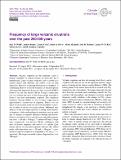Frequency of large volcanic eruptions over the past 200 000 years
Abstract
Volcanic eruptions are the dominant cause of natural variability in climate forcing on timescales up to multidecadal. Large volcanic eruptions lead to global-scale climate effects and influence the carbon cycle on long timescales. However, estimating the frequency of eruptions is challenging. Here we assess the frequency at which eruptions with particular deposition fluxes are observed in the EPICA Dome C ice core over the last 200 kyr. Using S isotope analysis we confirm that most of the largest peaks recorded at Dome C are from stratospheric eruptions. The cumulative frequency through 200 kyr is close to linear, suggesting an approximately constant rate of eruptions. There is no evidence for an increase in the rate of events recorded in Antarctica at either of the last two deglaciations. Millennial variability is at the level expected from recording small numbers of eruptions, while multimillennial variability may be partly due to changes in transport efficiency through the Brewer–Dobson circulation. Our record of events with sulfate deposition rates > 20 and >50 mg m−2 contains 678 and 75 eruptions, respectively, over the last 200 kyr. Calibration with data on historic eruptions and analysis of a global Quaternary dataset of terrestrial eruptions indicates that sulfate peaks with deposition rates > 20 and >50 mg m−2 correspond to explosive eruptions of magnitude ≥ 6.5 and ≥7, respectively. The largest recorded eruption deposited just over 300 mg m−2.
Citation
Wolff , E , Burke , A , Crick , L , Doyle , E A , Innes , H , Mahony , S H , Rae , J W B , Severi , M & Sparks , R S J 2023 , ' Frequency of large volcanic eruptions over the past 200 000 years ' , Climate of the Past , vol. 19 , pp. 23–33 . https://doi.org/10.5194/cp-19-23-2023
Publication
Climate of the Past
Status
Peer reviewed
ISSN
1814-9324Type
Journal article
Description
Funding: This research has been supported by the Leverhulme Trust (grant RPG-2015-246), by a Royal Society Professorship (grant no. RP/R/180003), and by a Marie Curie Career Integration Grant (CIG14-631752).Collections
Items in the St Andrews Research Repository are protected by copyright, with all rights reserved, unless otherwise indicated.

